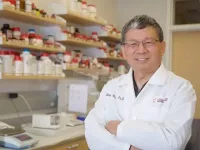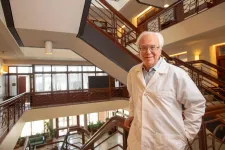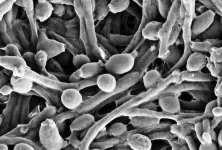(Press-News.org) ITHACA - Ligands are much like nanosized barnacles, binding to many kinds of surfaces. This form of adsorption is crucial for a range of chemical processes, from purification and catalysis to the design of nanomaterials.
However, understanding how ligands interact with the surface of nanoparticles has been a challenge to study. Adsorbed ligands are difficult to identify because there are other molecules in the mix, and nanoparticle surfaces are uneven and multifaceted, which means they require incredibly high spatial resolution to be scrutinized.
Cornell researchers led by Peng Chen, the Peter J.W. Debye Professor of Chemistry in the College of Arts and Sciences, have used a breakthrough imaging technique they pioneered in 2019 to obtain a high-resolution snapshot of these surface interactions and gain new understanding of the strength, or affinity, of ligand adsorption as well as how multiple ligands cooperate - or don't - with each other.
This led to an unexpected discovery: By varying the concentration of an individual ligand, the researchers found they can control the shape of the particle it stowed aboard - an approach that could result in an array of daily applications, such as removing micropollutants from the environment.
"When the molecule adsorbs on the surface of a nanoscale material, it also actually protects the surface and makes it more stable," Chen said. "And this can be utilized to control how nanoscale particles grow and become their eventual shape. And we found we can do this with just one ligand. You don't do any other trick. You just decrease the concentration or increase the concentration, and you can change the shape."
The group's paper, "Nanoscale Cooperative Adsorption for Materials Control," published July 13 in Nature Communications. The lead authors are postdoctoral researchers Rong Ye, a Presidential Postdoctoral Fellow, and Ming Zhao.
A nanoparticle's size and surface structures, or facets, are intrinsically tied to the particle's potential applications. The larger the particle, the more atoms fit inside it, while smaller particles have less available space internally but a greater surface volume ratio for atoms to sit atop, where they can be utilized for processes such as catalysis and adsorption. The different types of structures the atoms and molecules form on these surface facets are directly correlated with the particle's shape.
Scientists have used several imaging methods to survey these particles, but they haven't been able to obtain nanometer resolution to really explore the nooks and crannies of the multiple surface facets and quantify the affinity of a ligand's adsorption. Chen's team was able to do just that by employing a method it devised, called COMPEITS - short for COMPetition Enabled Imaging Technique with Super-Resolution.
The process works by introducing a molecule that reacts with the particle surface and fluoresces. A nonfluorescent molecule is then sent to bind to the surface, where its reaction competes with the fluorescent signal. The resulting decrease in fluorescence - essentially creating a negative image - can then be measured and mapped with super high resolution.
Using COMPEITS on a gold nanoparticle, the team was able to quantify the strength of ligand adsorption, and they discovered just how diverse ligand behavior can be. Ligands, it turns out, are fair-weather friends of a sort: At some sites, they cooperate to help each other adsorb; at others, they can impair each other's efforts. Chen's team also discovered that sometimes this positive and negative cooperativity exists at the same site.
In addition, the researchers learned that the surface density of adsorbed ligands can determine which facet is dominant. This "crossover" inspired the team to vary the concentrations of individual ligands as a way to tune the shape of the particle itself.
"For us, this has opened more possibilities," Chen said. "For example, one way to remove micropollutants, such as pesticides, from the environment is to adsorb micro-portions on the surface of some adsorbent particle. After it is adsorbed on the surface of the particle, if the particle is a catalyst, it can catalyze the destruction of the micropollutants."
The research was primarily supported by the Army Research Office, an element of the U.S. Army Combat Capabilities Development Command's Army Research Laboratory.
"Professor Peng Chen's work allows for deep insights into molecular adsorption processes, which is important to understand for designing molecular sensors, catalysts and schemes to clean up micropollutants in the environment," said James Parker, program manager with the Army Research Office. "This research is also important for designing and engineering stimuli-responsive materials with specialized function that could not be found in regular, bulk materials."
INFORMATION:
Additional support was provided by the Center for Alkaline-Based Energy Solutions, an Energy Frontier Research Center of the U.S. Department of Energy.
Contributing authors include postdoctoral researcher Xianwen Mao; Heting Pu, M.S. '20; doctoral student Zhiheng Zhao; and research assistants Zhaohong Wang and Diego Garzón.
The researchers made use of the Cornell Center for Materials Research, which is supported by the National Science Foundation's Materials Research Science and Engineering Center program.
ALBUQUERQUE, N.M. -- For decades, scientists have tried to make reliable lithium-metal batteries. These high-performance storage cells hold 50% more energy than their prolific, lithium-ion cousins, but higher failure rates and safety problems like fires and explosions have crippled commercialization efforts. Researchers have hypothesized why the devices fail, but direct evidence has been sparse.
Now, the first nanoscale images ever taken inside intact, lithium-metal coin batteries (also called button cells or watch batteries) challenge prevailing theories and could help make future high-performance batteries, such as for electric vehicles, safer, more powerful and longer lasting.
"We're learning that we should be using separator materials tuned for ...
BIRMINGHAM, Ala. - Uveal melanoma, or UM, is a rare and deadly cancer of the eye, and the mortality rate has remained unimproved for 40 years. Half of the melanomas spread to other organs of the body, causing death in less than a year, so new treatments to preserve vision and prevent death are an urgent need.
Now a preclinical study by researchers at the University of Alabama at Birmingham and Emory University, Atlanta, offers hope -- a small molecule inhibitor has been identified that dampens the potent drivers of this tumor. In mouse models, the inhibitor, KCN1, strongly limited primary disease in the eye and metastatic tumor dissemination ...
Male seed beetles with genital structures that injure females may have greater reproductive success. As new research from Uppsala University shows, females that mate with such males benefit, in the sense that their offspring are healthier. This new piece of the puzzle will help scientists to understand how complex mating interactions between males and females have developedevolved. The study is published in Proceedings of the Royal Society B.
"This helps us understand is connected with the evolutionary dance between males and females of all animal species, ...
A team of University of Houston pharmaceutical researchers is reporting a newly recognized process of drug metabolism in the intestines - followed by recycling through the liver - that could have important implications for developing treatments for intestinal diseases and for taking multiple medications at the same time.
"The intestines play a crucial role in metabolizing and recycling certain plant compounds and drugs," reports Ming Hu, Diana S-L. Chow Endowed Professor of Drug Discovery and Development and the senior author of the paper in eLife. "The discovery has important implications for scientists trying to understand how ...
A new study led by the U.S. Geological Survey outlines a means to better estimate COVID-19 occurrence and trends in populations.
Currently, COVID-19 testing is primarily limited to self-selected individuals, many of whom are symptomatic or have had contact with someone who is symptomatic. While these tests are useful for individual medical treatment and contact tracing, they do not provide health officials with a complete picture of the disease across the population.
"Coordinated sampling of COVID-19 is key to informing health officials as they continue their efforts to control the pandemic, permitting better predictions of disease dynamics and ...
Antibiotic exposure early in life could alter human brain development in areas responsible for cognitive and emotional functions, according to a Rutgers researcher.
The laboratory study, published in the journal iScience, suggests that penicillin changes the microbiome - the trillions of beneficial microorganisms that live in and on our bodies - as well as gene expression, which allows cells to respond to its changing environment, in key areas of the developing brain. The findings suggest reducing widespread antibiotic use or using alternatives when possible to prevent neurodevelopment problems.
Penicillin and related medicines (like ampicillin and amoxicillin) are the most widely used antibiotics in ...
Scientists at Northwestern University in Evanston, Illinois have developed a hydrogel integrated with zirconium-based robust metal-organic frameworks (MOFs) that rapidly degrades organophosphate-based nerve agents used in chemical warfare. Unlike existing powdered MOF adsorbents, this hydrogel composite does not require added water and may be easily scaled up for use in protective masks or clothing. The work appears July 14 in the journal Chem Catalysis.
"Organophosphate-based nerve agents are among the most toxic chemicals known to humanity," says senior author Omar Farha, a professor of chemistry at Northwestern University. "Their use in recent global conflicts reflects the urgent need for personal protective gear, as well as the bulk destruction of ...
(Salt Lake City) - Bacteria's role in gut health has received a lot of attention in recent years. But new research led by scientists at END ...
BOSTON - New research in humans and mice identifies a particular signaling molecule that can help modify inflammation and the immune system to protect against Alzheimer's disease. The work, which was led by investigators at Massachusetts General Hospital (MGH), is published in Nature.
Cognitive decline associated with Alzheimer's disease develops when neurons begin to die. "Neuron death can be caused by improper immune responses and excessive neuroinflammation--or inflammation in the brain--triggered by high levels of amyloid beta deposits and tau tangles, two hallmarks of Alzheimer's disease," explains the paper's co-senior author Filip Swirski, PhD, who conducted the work while a principal investigator in the Center for Systems Biology at MGH. ...
BOSTON - Over the last decade, investigators at Beth Israel Deaconess Medical Center (BIDMC) have been at the forefront of the effort to END ...





